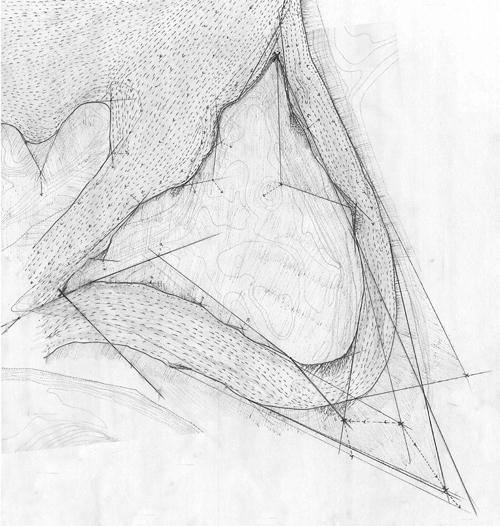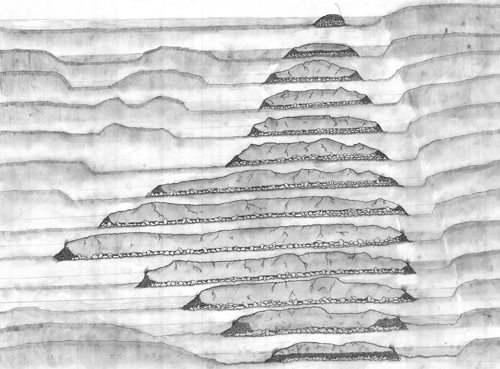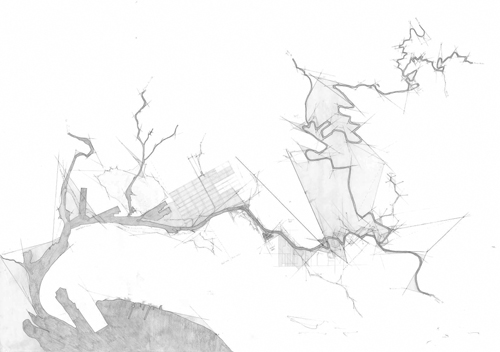Plotting an Unfinishable Landscape Architectural Project: By Way of Beginning...
by Kate Church
published November 2014
Plot (n): a narrative device that establishes the order of events
a measured parcel of land
Plot (v): the activity of making by drawing
to come up with a strategy (often secretly)
Common uses of the term “plot” suggest that its complexity and usefulness resides in four different meanings: a narrative device, a construction of a site, a cartographic act, and an identification of a strategy. For the purpose of this NANO note, however, three additional connotations of the transitive verb “to plot” serve to thread several ideas together: to order, to measure, and to locate. In short, the term plot is a launching point that helps me to examine the concept of “openness” in relation to narratives, cartographic drawing practices, and the landscape.
Umberto Eco in The Open Work situates openness as a generative structuring device, conceiving of the open work as an outcome that enables multiple (but finite) possibilities to co-exist (1-6). Using Karlheinz Stockhausen and Stéphane Mallarmé as examples of works that operate within such a structure, Eco identifies the characteristic of multiplicity in the considerable autonomy left to the performer/reader in interpreting the work, as opposed to presenting a singular outcome or correct interpretation. These works are created with multiple versions embedded in both their structure and conception. He cites Henri Pousseur’s description of his piece Scambi as “not so much a musical composition as a field of possibilities, an explicit invitation to exercise choice” (Eco 1). This invitation positions any single performance of Scambi as one of many different but related trajectories woven through the material provided by Posseur.
Rather than a repeatable outcome, an open work offers a constellation of complementary possibilities—providing stimulus and points for departure. Within a landscape architectural context, open structures offer designers a way of engaging with the continuum of change in the landscape. As an open work, a project contains a number of possible outcomes which are not (and cannot be) completely determined by the designer. The inherent multiplicity and indeterminacy of open structures has implications regarding how a designer conceives a project, how the design process unfolds, and how others engage with its outcomes.
The following paper examines the notion of open structures through reassembling the process of an unfinished (and unfinishable) project, Siltscape, which I began in 2012. In keeping with the notion of open structures, this discussion attempts to present a set of narrative threads which reflect upon and reorganize my design process as a collection of possible plots. This is necessarily a selective re-telling of an assortment of decisions, events, and artifacts retrospectively reorganized as a series of beginnings. The emphasis on beginnings allows the project material to be presented in a manner that suggests a range of different possible outcomes.
The Siltscape project consists of a variety of collected and produced material that spans a range of modes. The project currently consists of: a body of historical source material, a fictional alter-ego situated within this historical context, a text in four episodes (though without a conclusion), a reversible garment, and a set of propositional and cartographic drawings. Each mode weaves various trajectories between historical fact and fiction.
Cumulatively this material does not form a single, cohesive project but offers multiple possible outcomes. In this respect, the constellation of material offers a structure that allows it to operate as an open work enabling different versions of the project to be constructed by the reader/viewer and echoes Posseur’s characterization of open works as offering an “explicit invitation to exercise choice” (Eco 6).
The processes for creating and collecting this material operated concurrently, with the different parts of the project developing alongside each other. Ideas, tactics, and techniques merged with and influenced adjacent aspects: crossing mediums quite organically. Collectively this has resulted in a project which contains multiple possibilities of itself. Each version unfolds somewhat differently depending on how the material is ordered and how people engage with it.
An open structure necessarily problematizes the conceptualization of a singular or linear project outcome. In structuring this written description of Siltscape as a set of beginnings, these multiple versions suggest different points at which the work can be entered into. Each beginning constructs a different project narrative through reorganizing the project material. Each narrative privileges and reframes different project components and thereby establishes different hierarchies of information and ideas. This open structure creates interconnections and fluid relationships between different elements of the project material which, in turn, facilitates the ongoing exploration of ideas.
Similarly, landscapes operate as a set of complex and fluid relations that are spatially, materially, and temporally interconnected (Corner 146-49; Weiss 91; Waldheim 39). In this respect, landscapes are continuums of change characterized by open-endedness. Open structures offer a way to situate a process of design (and its retelling) in a manner which explicitly engages with this understanding of the landscape as fluid and open-ended, and embraces its capacity for perpetual change.
Just as the set of beginnings that comprises this NANO note may be classified as simulated or artificial (in that they have been retrospectively created as an exploration of open structures), so too the constructed borders that divide space into landscapes may be characterized as similarly creating simulated beginning and endpoints. These partitions of land are human constructs, artificial categorizations, carved out by a line on a map, or a physical boundary, or a set of policies. These divisions of space emerge for pragmatic reasons and help to make sense of the seemingly infinite.
While ordnance surveys and political overlays offer the illusion of orderly division on cadastral maps (through lines that divide the land into plots and, in doing so, create sites with distinct beginning and end points) and colonial or creation narratives of place emerge from events retold as stories that build or impart a sense of place to a particular group of people (narrative plots that re-allocate temporal beginnings and endings) these plots both assume that landscape can be somehow contained–spatially and temporally. A design methodology that utilizes open structures offers an approach that interferes with these divisions, recalibrates their agency, and corrupts their Cartesian orthodoxy. Openness as the basis for a project structure aligns with conceptualizing the landscape as uncontainable.
In grappling with both the need for narrative coherence and the desire to utilize open structures, the following set of versions of Siltscape each offer a different possible beginning to the overall project. This allows the reader to decipher these fragments and piece together their own version, in effect forming their own temporal and material version of this landscape.
Plot (n): a narrative device that establishes the order of events
Chronological beginnings…
36 people dead
250 people injured
6000 people homeless
A collection of statistics forms the beginning of the Siltscape project: the human toll of Melbourne’s 1934 flood. These three lines of data synthesize and quantify this storm event. The numbers insinuate the collective significance of this disaster and suggest individual trajectories as well as formulating a chapter in the narrative of the city’s history. Compiled after the fact by historians (Fraser 574; Writer 60-69) the numbers offer a cumulative reading which omits insight into a narrative sequence of events. These figures present an audit of the aftermath. Their empirical elements create a chronological beginning for the project: returning to the early days of December which saw the city become the recipient of an unusually severe torrential downpour. 350 millimeters of rain that fell in 48 hours. Dubbed the city’s worst flood of the 20th Century (Dingle and Brown-May), the Yarra River broke its banks and continued rising. It peaked at 12 meters above its usual height transforming Melbourne into “a single lake from South Yarra to Warrandyte.”
The floodwaters inundated and washed away much of Como Island (now Herring Island), the Yarra’s only island (albeit an entirely artificial one). Ironically the island itself, which lies 3 kilometers from the city, was created as part of the Melbourne Metropolitan Board of Works’ flood mitigation strategy in 1928 (Dingle and Rasmussen 124).
The 1934 flood washed away the levee and much of the island. In ensuing years, a small army of men rebuilt the island. Using dredged silt, the levee was strengthened and enlarged, and today stands over 5 meters above the high waterline. Herring Island, as it is now known, has successfully withstood subsequent flooding.
A Protagonist’s Beginning…
She has something of a secret…
To meet her is to see a slight, neatly presented, unmemorable creature. Her clothes are plain—well tailored but plain. Outfits tastefully but unimaginatively put together … outfits that make her blend perfectly, unremarkably into a crowd. She lives alone in a neat apartment on the fringe of the city. It is small, its proportions slightly mean; pinched spaces and narrow doorways. But it is light and well maintained. From her bathroom window, if she cranes her neck, she can just catch a glimpse of the sunlight glinting on the Yarra…
[Church, Kate. excerpt from Siltscape. 2012.]
April Thrippingston. Baker. The Siltscape project began as a name for my alter-ego. Assigning a name, is almost a cartographic act, enabling an entity, previously vague and formless, to assume an identity, constructing coordinates which locate it within a larger system of meaning. Providing my protagonist with these coordinates, gave her form and a certain authority through an implied identity, a niche within this larger system.
Her name needed to be appropriate to the mental image of her that had begun to form in my mind. But her name–April Thrippingston–was also generative. It suggested certain characteristics and resisted others. Emerging over time, her narrative voice shaped the project. I spent days imagining her. She gradually grew familiar and my mental image of her became quite distinct: I know exactly how she wears her hair for instance, and that her handwriting has a slightly uncertain, spidery quality to it. I am familiar with her embedded physical grace which I assume many women of her era had unconsciously acquired. I have a sense of how the physicality of handling dough imprints itself upon her other gestures. I know her bakery’s layout and its atmosphere—down to the thin layer of flour dust that settles on all surfaces over the course of a day, a short-lived palimpsest, registering traces of transaction before being swept up.
A MacGuffin-esque Beginning…
Look at April now—as she stands attentively in front of the baskets, the stock lying in wait. Watch her as she smooth’s her apron before she folds her hands in front of her. A new addition to the routine—an unconscious tic. […]
If her customers look closely they may even spot the changes to the stitching, or the strange bulging areas, or even the odd way it hangs, its peculiar heaviness. She has done her best to disguise it, but her apron is transformed.
[Church, Kate. excerpt from Siltscape. 2012]
Alfred Hitchcock mastered the MacGuffin; an object which drives the actions of characters as they try to obtain it (or in this case make it), but whose actual nature is inconsequential to the story (Spoto xi). In my project, it was the fabrication of a garment that enabled the protagonist’s fabrication.

I constructed the garment before I wrote any of April’s story, before any of the drawings had commenced. The decisions that I made while designing and constructing the garment occurred over weeks and this process inflected her personality.
As the Siltscape project’s first tangible outcome, the reversible apron facilitated many details of her narrative (creating those small tell-tale eccentricities which seemed to swiftly transform the generic to the highly particular), as well as providing a catalyst for the plot to unfold. The writing of her version of events (third person, present tense) gradually transfers onto me, and I begin to embody her. I sat slightly differently (more upright, head slightly tilted) when I wrote–and the language was particular to her; but this was a disrupted and divergent osmosis. For she too absorbed influences from me–books I was reading, conversations I was having, knowledge I was gaining about the island…and her story had to tussle with the emerging facts of the events of 1934. Fiction and non-fiction were sometimes combative, like boxers, eying each other off. These are tense moments for a writer where the fragile structure of the story, suspended between the concrete and the imagined threatens to dissolve. Facts and statistics simultaneously had to provide the plot’s foundation and April’s point of departure.
That said, I remember there was a defined point in the writing where April took the reins and the narrative trajectory truly started to become hers. Which is not to declare that April precisely determined the unfolding of events from that point onward. But there was a moment when I realized that her personality and tendencies, while fictional, were now defined enough to set up parameters.
Fiction, while still loaded with convention, enables a particular openness of structure. In moving between fact and fiction, this openness was both constricted and released by my historical research. The project’s fictional narrative operated within an open structure—imagination has been employed but not to construct a totally fictional outcome (if such a thing exists), but to work within the parameters emerging from the historical research.
Plot (n): a measured parcel of land
Fluid Beginnings…
Today the Yarra River that flows between the Central Business District and Southbank […] is as artificial as the high rise buildings that currently line its banks. (Presland 218)
The Siltscape project began with the Yarra River. Well, the above quote about the Yarra to be precise. It is intriguing, this artificiality is obvious in the Yarra’s surface treatment—its boulevard of trees and manicured edges—yet I had not realized the extent of its constructedness. Of course, it seems obvious now, but the cumulative scope of the changes which had occurred over decades was surprising: tributaries entirely covered over, bends ironed out, waterfalls dismantled. The sedate river we know today is unrecognizable in John Helder Wedge’s description quoted in Gary Presland’s The Place for a Village:
[a] twisted cantankerous river […] so choked with the trunks and branches of trees and other obstructions that it renders its navigation a matter of difficulty and delay to even the smallest coasters. (89)
Can it be the same river? Has it been entirely tamed and subservient to engineered predictability? Can it change character to that extent?
These questions situate the Yarra as an active player in the project. Already the physical and historical catalyst, it suggests a set of hidden or alternative traits in the material nature of the river. Its potential duality questions the material characteristics of the site as well as highlighting (through the desire to control) the problematic of considering a liquid landscape as a contained parcel of space.
The Island as Beginning…
The island […] hums with activity. Weeks pass and a hidden legion of men inhabit the island loosely fashioning dusty hillocks with spades and picks. She cannot see them behind the levee but hears a steady concert of voices and dull thuds.
~
Then, all of a sudden, the machines and the men are gone. The silt-scaped island stands empty, dust-blown and barren […] The politicians are hailing it as a “triumph of modern engineering.” Controlling future floodwaters, enforcing control over nature’s capriciousness. But as a baker, familiar with the fluid alchemy of her ingredients and her bread’s receptiveness to atmospheric shifts, she privately doubts that the island will fully submit to its engineered confines.
[Church, Kate. excerpt from Siltscape. 2012.]
The Siltscape project began with the island—it had to. What a strange and wonderful place! That such a large island, so close to the city can seem so secret is baffling. How had I not really noticed it before?
Stepping out of the kayak and into a parallel universe—its otherworldliness never quite left me. Initially I did not perceive the island as artificial—its revegetation successfully camouflages the clues that are everywhere, hiding.
Because it is artificial, the beginning of the Island’s life is clear to pinpoint: 1928, when the indentations from a former quarry were expanded and the course of the river diverted to flow through it. This act straightened the river, lessening its propensity to flood. With water now flowing on both sides of the bend, the island was created and enhanced by dumping dredged silt from a downstream flood mitigation project.

As a flood-proofing measure, this iteration of the island was spectacularly unsuccessful. The 1934 flood all but obliterated the newly formed island.
It was reconstructed in ensuing years, again using dredged silt. The levee was strengthened, enlarged, and today stands over 5 meters above the waterline. These silt fortifications have created very particular spatial qualities. As visitors enter the island, the high levee provides a visual and aural barrier—the hum of the city traffic fades and the buildings disappear. Islands can be like fishbowls with everyone looking in, but a visit to this island is an intensely private experience. While Como/Herring Island was constructed as an engineering project to solve the problem of flooding, today it can seem more like the materialization of someone’s imagination. Like the secret walled gardens, we read about as children, mystical and full of possibilities.

Herring Island, as it is now known, has successfully withstood subsequent flood events. Successful that is until its next iteration—which is April’s point of departure…
Plot (v): the activity of making by drawing
Overlaid beginnings …
Siltscape began with a small side project. I had collected a set of historic surveys and maps of Melbourne and its river, which though not exhaustive, span from 1850 until today. The collected maps were not evenly spaced chronologically, but were clustered. They suggest a pattern emerging of severe weather events followed by bursts of activity aimed at reshaping and controlling the Yarra, re-forming it, straightening the landscape into submission.
I redrew these maps as a single drawing which located and overlaid all the changes to the course of the river since white settlement.

The order of events is not evident in this map so the current Yarra and the ghosts of its former self merge. The river’s changes consist entirely of artificial reconstructions which have occurred since the colony of Melbourne was settled. To look at Harold Fisk’s stunning maps of the Mississippi River, one sees these similar changes represented on a geologic time scale. Large sections of the Yarra operate as artificially sped-up microcosms of this geomorphological change.
The project’s cartographic process, initially involved digitally redrawing all the maps in order to have a consistent scale. The maps were vastly different and in themselves suggest a multitude of narratives about the city’s settlement and expansion, as well as its rejection and reacceptance of the river. The final drawing attempts to have the trappings of a conventional map—suggesting accuracy, authority and a certain clarity. Yet it does not feel satisfactorily accurate, despite tailoring the process to privilege this. For example, in some cases I could not tell which differences in the river’s course are real and which are the result of historic cartographic inaccuracies. In the age of satellites and GPS, high-level accuracy is assumed, but for the wandering surveyor in 1863 there were often embedded inaccuracies in the surveying process. Drawing conventions too were different, the world was often not uniformly projected onto the page, things were foreshortened, warped, and estimated allowing moments of whimsy and utter subjectivity. I read these cartographies as particular fictions.
So this re-mapping preceded April’s written narrative—it was the matter from which Siltscape emerged—and its true beginning.
Beginning With A Proposition…
Initially her/my drawings seemed disparate and oddly directionless, existing only as vague ambitions; each one tossed up questions that seemed to demand the completion of other drawings. They were jumbled at first–so that things had to be re-drawn as April’s narrative shifted and the drawings would have to respond. These changes occurred not because the mappings were intended to illustrate the text (for they are inflected with a slightly different version of events), but rather because the developing narrative required a drawn counterpart that mapped out or counteracted other trajectories that had emerged. The mappings straddle the past and the projective, qualitative and quantitative data, and fact and fiction.

Drawing is a different process of assembling thoughts and ideas to text. Whereas text privileges a linear unfolding, the process of constructing a drawing is messier and more capricious. Just as April’s fictional narrative had to negotiate and integrate historical facts, the process of producing the drawings required a similar wrangling to occur, in order to fuse the imagined elements with existing cartographic data.
These drawings offer further propositional possibilities when considered in relation to the rest of the project’s material. They combine with the text, garment, and source material to form sub-plots and alternatives, creating a set of interrelated versions of the project.
Plot (v): to come up with a strategy (often secretly or deviously)
Towards loose ends
As both an idea and a set of material the Siltscape project remains a series of versions that begin but do not conclude. The inherent unfinishedness invites the reader/viewer to construct their own means of traversing the material. This quality of unfinishedness aligns with landscape processes which are perpetually changing (and therefore elude a finished or final state). In exploring this characteristic of the landscape, open structures offer an analogous condition, similarly evading sense of finality through embedding multiple trajectories into the structure.
Works that emerge from open structures “reject the definitive, concluded message and multiply the formal possibilities of the distribution of their elements” (Eco 3). Within the Siltscape project, any sense of an ending seems necessarily arbitrary. The material continues to be unsettled and in motion, as it gets augmented and reconstituted to offer new versions. Eco identifies such “intrinsic mobility” (12) as characteristic of openness, borrowing Pousser’s characterization of open works as “works in motion.” Siltscape, like the fluid condition of landscape itself, exists as a work in motion, a field of possibilities, an explicit invitation to exercise choice…
…to be continued
Works Cited
Corner, James. “Representation and Landscape (1992).” Theory in Landscape Architecture: A Reader. Ed. Simon Swaffield. Philadelphia: U of Pennsylvania P, 2002. 144-165. Print.
Dingle, Anthony Edward, and Andrew Brown-May. “Yarra River.” eMelbourne The City Past and Present. n.p., n.d. Web. 24 Jan. 2013.
Dingle, Anthony Edward, and Carolyn Rasmussen. Vital Connections: Melbourne and its Board of Works, 1891-1991. Ringwood, Victoria: McPhee Gribble. 1991. Print.
Eco, Umberto. The Open Work. Trans. Anna Cancogni. Cambridge: Harvard UP. 1989. Print.
Fisk, Harold. The Alluvial Valley of the Lower Mississippi River. 1944. Radical Cartography. Web. 5 June 2013.
Fraser, Bryce. Macquarie Book of Events. Netley, South Australia: Macquarie Library Pty. Ltd. 1984. Print.
“History of the Yarra River.” Melbourne Water. n.p., n.d. Web. 24 Jan. 2013.
Presland, Gary. The Place for a Village: How Nature Shaped The City of Melbourne. Melbourne: Museum Victoria. 2008. Print.
Spoto, Donald. The Art of Alfred Hitchcock: Fifty Years of His Motion Pictures. New York: Anchor 1992. Print.
“The December 1934 Floods in Melbourne.” Bureau of Meteorology. n.p., n.d. Web. 5 Apr. 2013.
Waldheim, Charles. “Landscape as Urbanism.” The Landscape Urbanism Reader. Ed. Charles Waldheim. New York: Princeton Architectural P 2006. 35-54. Print.
Weiss, Allen S. Unnatural Horizons, Paradox and Contradiction in Landscape Architecture. New York: Princeton Architectural P 1998. Print.
Writer, Larry. The Australian Book of Disasters. Millers Point, New South Wales: Murdoch 2011. Print.

